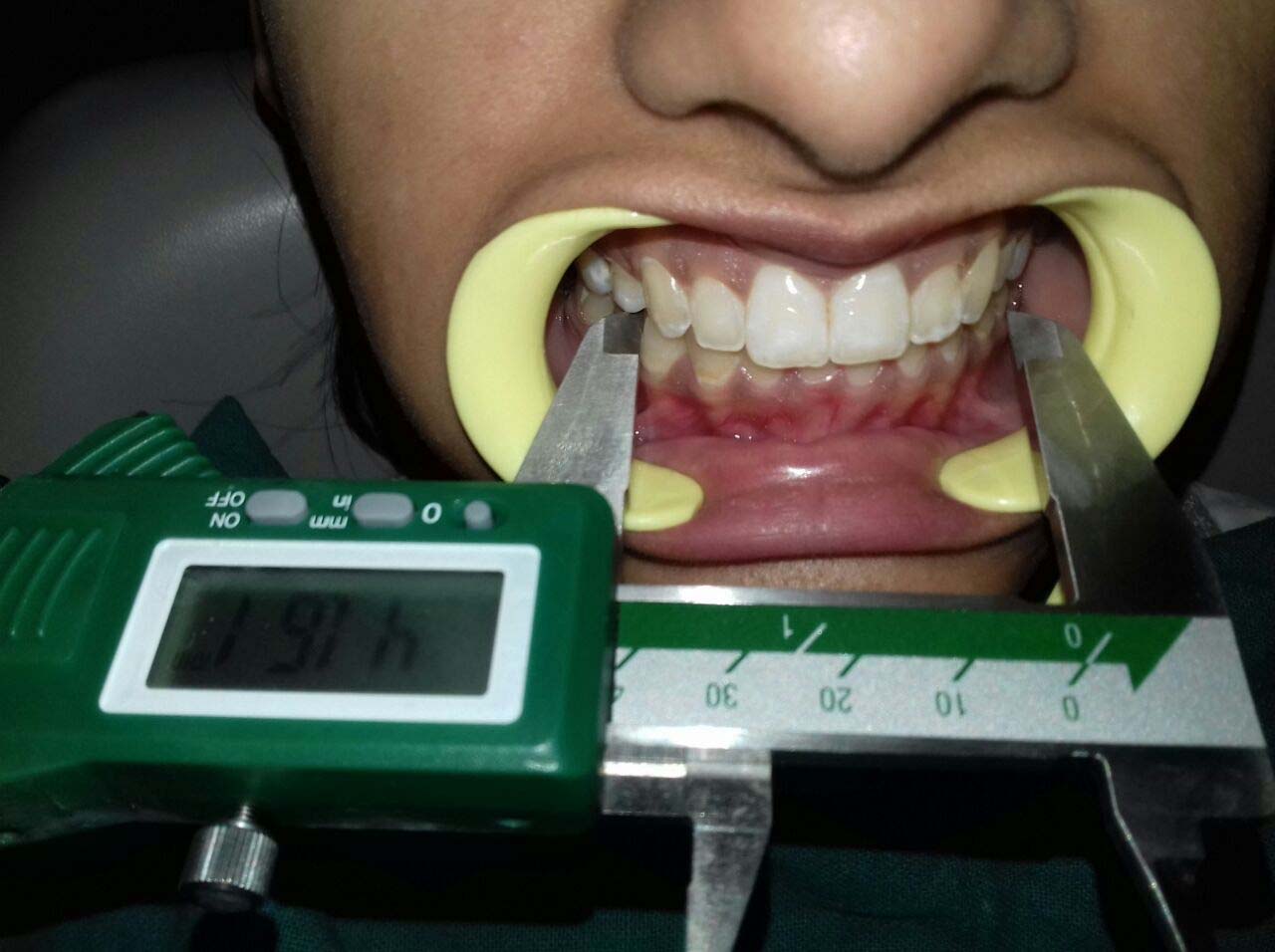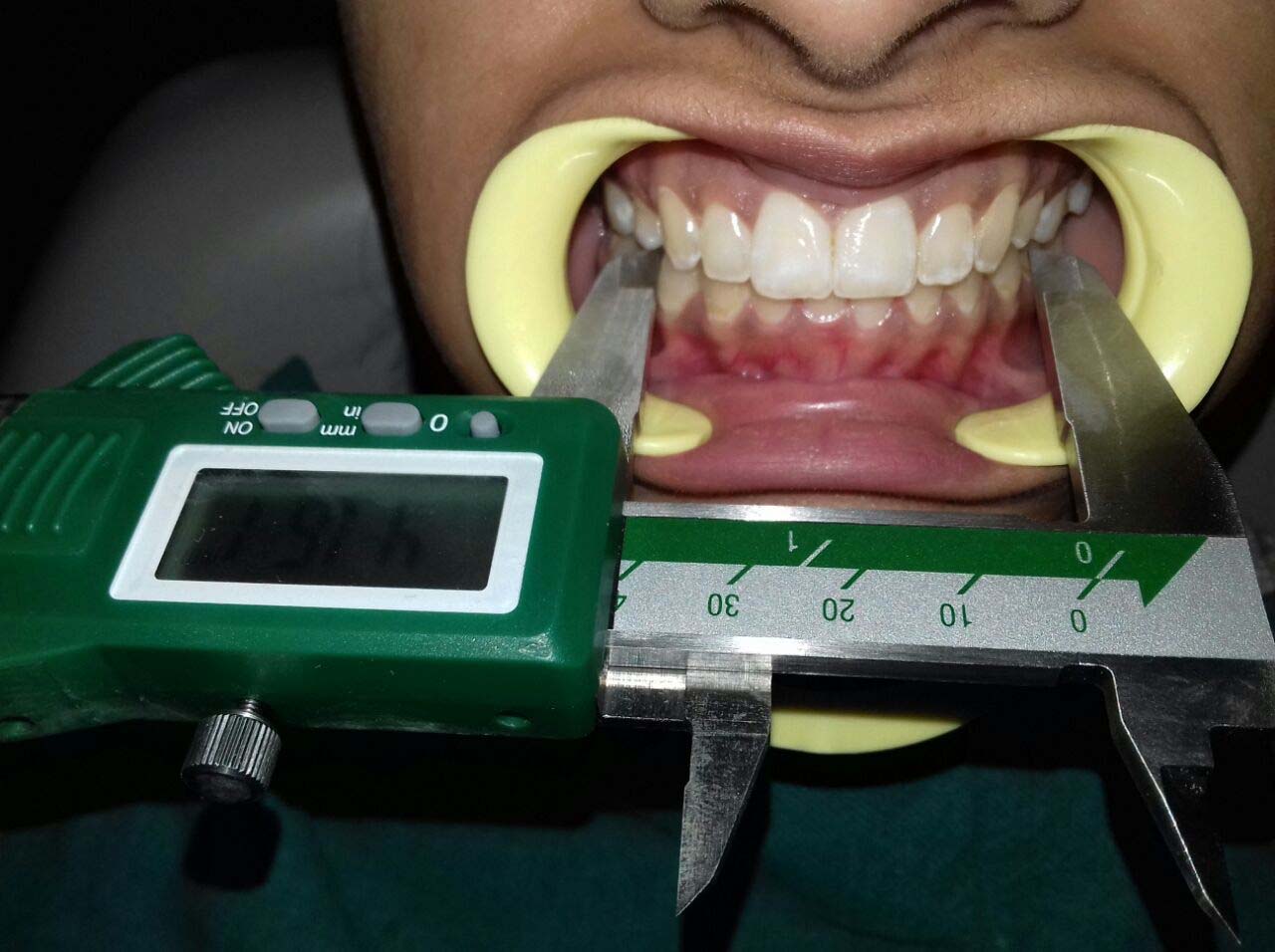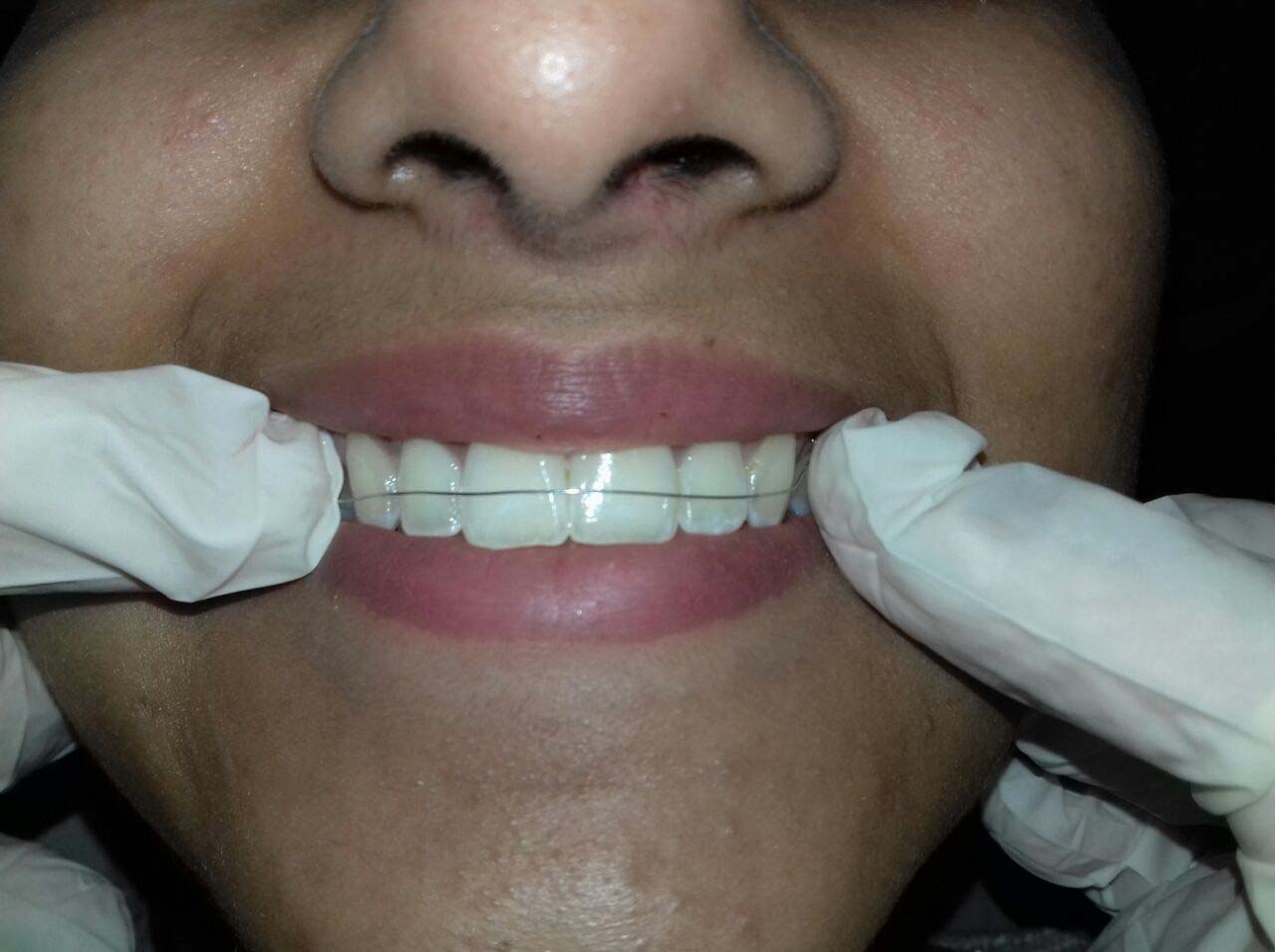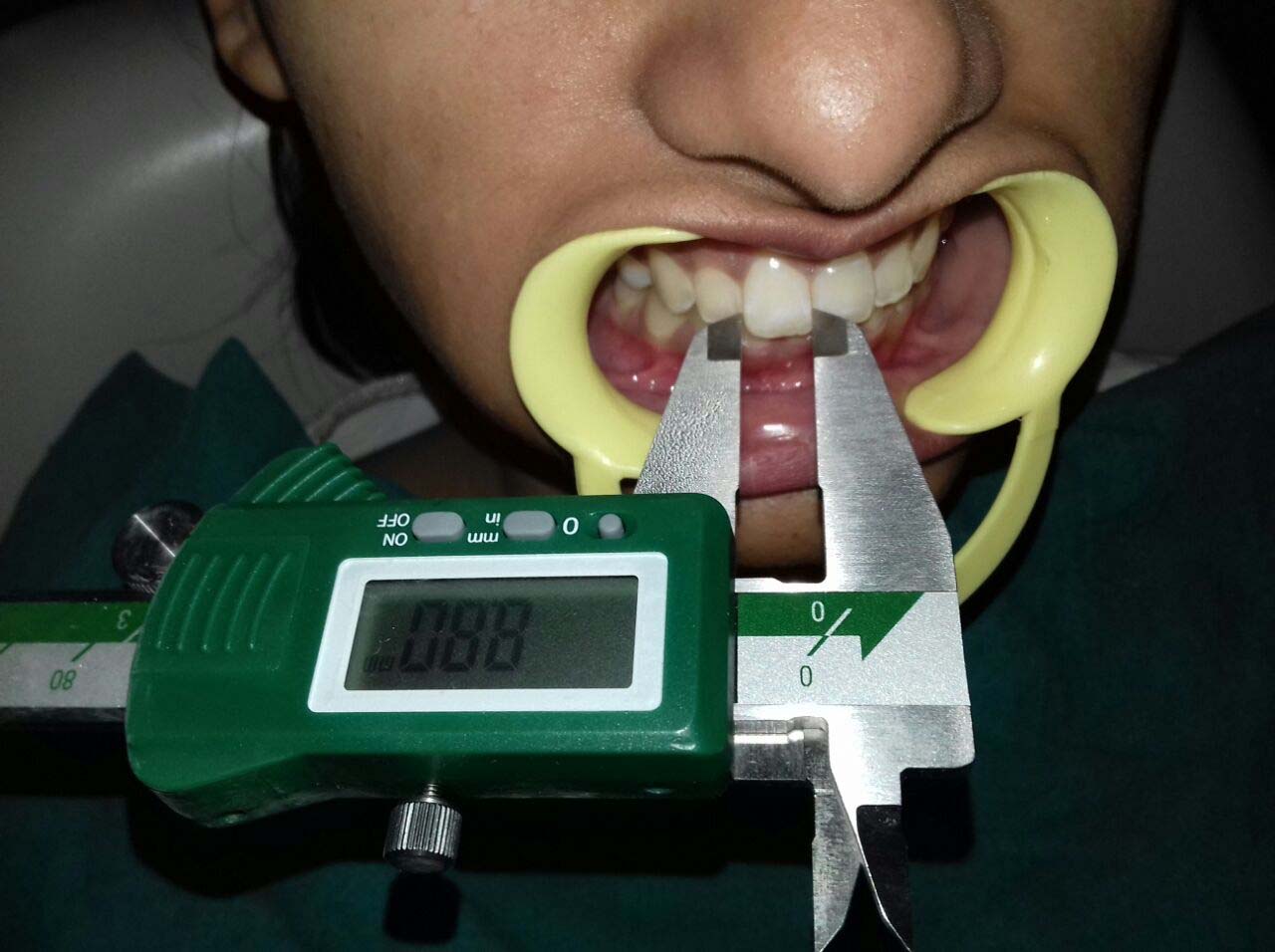Introduction
In contemporary human population, males exhibit larger size of dentition as compared to females. Additionally, these odontometric parameters show variation in members of same species and also show regional variation.
Aim
To evaluate sexual dimorphism of four maxillary odontometric parameters such as Intercanine Width (ICW), Interpremolar Width (IPW), Arch Length (AL) and Combined Width (CW) of six maxillary anterior teeth, to determine percentage of sexual dimorphism of all four odontometric parameters singly or in combination and also to determine sensitivity, specificity and overall accuracy of odontometric parameters for sex determination.
Materials and Methods
This cross-divtional study was conducted on 200 subjects (100 males, 100 females). Four odontometric parameters ICW, IPW, AL and CW were measured directly on the subject and the data thus collected was subjected to statistical analysis.
Results
Discriminant statistical analysis (d square test) revealed that all the four odontometric maxillary parameters exhibited greater mean values in males as compared to females. The difference was found to be statistically highly significant (p<0.001) for ICW and IPW for sexual dimorphism. Also, combination of parameters such as ICW, IPW further improved assessment.
Conclusion
The study concluded that linear odonotometric parameters ICW, IPW along with AL, CW show significant sexual dimorphism. Hence, odontometric parameters offer simple, reliable and cost-effective way of determining sex in any forensic investigation.
Introduction
Gender determination is of chief importance in any forensic investigation. Whenever, it is possible to determine sex, identification is simplified as then missing persons of that sex need to be considered. In this sense, recognition of sex takes preference over age [1].
Sex determination is usually done by osteometry [2], DNA analysis [3] and even by odontometric parameters [4]. The only method that can give a totally accurate result is the DNA analysis, but in many cases it cannot be used as it is expensive, not readily available, involves difficult DNA extraction technique, requires qualified trained staff [5]. On the other hand, osteometry is favoured procedure because it is more effective in determining sex [2]. However, those bodies which are badly mutilated, consisting of fragmentary remains of a skeleton, present problems in identification and in many instances may not be identifiable at all [6].
Sexual dimorphism represents a group of morphologic characteristics in form of shape or size that differentiate a male from a female [1]. Odontometric parameters of various species are known to exhibit sexual dimorphism [7]. In present human population, males show larger tooth dimensions than females [1].
In cases of fragmentary remains, maxillary odontometric parameters offer advantages as maxilla is firmly attached to the base of skull and teeth resist decomposition, fire, have standard anatomical landmarks which can be easily identified and methods used for measuring odontometric parameters are simple and give satisfying results [8].
Mesiodistal width, buccolingual diameters, canine index, ICW of the permanent teeth are most commonly used and researched features used in determining sex on the basis of dental measurements [8-11].
IPW, AL are widely used in the field of orthodontics for assessment of odontometric dimensions for tooth alignment corrections [12,13]. However, ICW and AL have not been evaluated for sexual dimorphism. Hence, IPW and AL are easily accessible and recorded measurements in dental clinics and hospitals which could prove to be helpful in making forensic odontology registry in India.
Also, mesiodistal dimension of anterior teeth have been studied for sexual dimorphism in Indian population [4]. However, combined width of maxillary anterior teeth has not been evaluated for sexual dimorphism.
A thorough review of available English literature shows anecdotal studies investigating sexual dimorphism in IPW, AL and CW. Thus, the aim of the present study was to evaluate sexual dimorphism for four odontometric parameters such as ICW, IPW, AL (Canine to canine) and CW of maxillary anterior teeth and also evaluate the accuracy with which these odontometric parameters could be employed for the gender determination.
Materials and Methods
This cross-sectional study was conducted over a period of three months from June 2016 to August 2016 in Outpatient Department of Genesis Institute of Dental Sciences and Research, Ferozepur, Punjab, India. During this period, 1164 subjects were found to be in age range of 20-30 years but only 219 subjects met the inclusion criteria applied for the study. A total of 19 subjects refused to participate in the study, therefore only 200 subjects (100 males and 100 females) were taken up for the study after obtaining informed written consent from the selected subjects.
Inclusion criteria: The study included subjects in age range of 20-30 years with fully erupted teeth, periodontally healthy, non-carious teeth.
Exclusion criteria: Subjects with physiological or pathological wearing away of teeth (attrition, abrasion, erosion), malaligned teeth (crowding, rotation or malocclusion, spacing), partially erupted teeth, any history of restoration, orthodontic treatment or trauma were excluded from the study sample.
All odontometric measurements were measured directly on the subject to an accuracy level of 0.1 mm with help of digital vernier calliper (Mitutoyo Digital Caliper, Japan) held parallel to the occlusal plane.
ICW was measured as linear horizontal distance between buccal cusp tips of right and left maxillary canines [Table/Fig-1]. IPW was further measured as horizontal distance between buccal cusp tips of maxillary first premolar teeth on both sides [Table/Fig-2]. AL was measured from distal surface of maxillary canine from right side to distal surface of canine (at maximum curvature of tooth) on left side using sterilized stainless steel wire [Table/Fig-3]. AL was measured in view of the fact that inclinations of individual tooth make significant difference in odontometric dimensions of patient when compared to CW. Hence in addition to measuring individual dimension of anterior teeth, AL also measures inclination of teeth.
Measuring the maxillary intercanine width by placing tips of vernier caliper on buccal cusp tips of canines horizontally.

Measuring the maxillary interpremolar width by placing tips of vernier caliper on buccal cusp tips of first premolars horizontally.

Measuring the arch length (from canine to canine) by placing wire in middle third of tooth (maximum curvature of tooth).

The combined width of maxillary anterior teeth was obtained by adding maximum individual mesiodistal dimension of permanent central incisors, lateral incisors and canines. The mesiodistal dimension was measured directly on the subject at the level of anatomic contact points of teeth [Table/Fig-4]. In situation wherever it was difficult to place the tips of vernier calliper due to tight contact points, manual divider with very fine tip was used for measurement which was again measured with digital vernier calliper.
Measuring the maximum mesiodistal dimension of maxillary central incisor with vernier caliper held at anatomic contact point.

In order to eliminate inter-observer error in the study, all measurements were done by single observer. All the four odontometric parameters were taken three times and average value of each parameter was recorded.
Statistical Analysis
Discriminant stastistical analysis was used for data evaluation with SPSS software version 17. Discriminant statistical analysis along with Student’s t-test was applied for calculation of sexual dimorphism.
Results
[Table/Fig-5] shows descriptive data of all four odontometric parameters singly and in various combinations. The mean values of all the four odontometric parameters when evaluated singly were found to be significantly higher in males as compared to females (p<0.001).
Descriptive data (Minimum, maximum, mean and standard deviation) of odontometric parameters according to gender.
| Parameter | Female | Male | p-value |
|---|
| Minimum | Maximum | Mean | SD | Minimum | Maximum | Mean | SD |
|---|
| CW | 40.18 | 53.69 | 45.36 | 2.76 | 39.40 | 59.50 | 46.22 | 3.45 | 0.053** |
| ICW | 29.07 | 39.48 | 35.64 | 2.19 | 31.86 | 42.99 | 37.64 | 2.45 | <0.001* |
| IPW | 38.30 | 46.81 | 43.17 | 2.10 | 38.71 | 53.08 | 45.60 | 2.97 | <0.001* |
| AL | 46.00 | 61.00 | 54.64 | 3.11 | 44.00 | 69.00 | 55.76 | 4.78 | 0.051** |
| CW±ICW | 72.55 | 93.17 | 81.00 | 3.98 | 71.98 | 96.31 | 83.85 | 4.96 | <0.001* |
| CW±IPW | 81.28 | 100.36 | 88.53 | 3.87 | 78.83 | 107.15 | 91.82 | 5.29 | <0.001** |
| CW±AL | 89.18 | 110.15 | 100.00 | 4.91 | 91.40 | 120.50 | 101.98 | 7.26 | 0.025* |
| ICW±IPW | 68.61 | 86.15 | 78.81 | 3.95 | 70.57 | 96.07 | 83.24 | 5.13 | <0.001* |
| ICW±AL | 80.07 | 97.38 | 90.28 | 4.23 | 78.22 | 111.99 | 93.40 | 6.30 | <0.001* |
| IP ±AL | 88.95 | 107.72 | 97.81 | 4.18 | 84.10 | 122.08 | 101.36 | 6.37 | <0.001* |
| CW±ICW±IPW | 113.41 | 139.84 | 124.17 | 5.45 | 110.69 | 147.47 | 129.45 | 7.22 | <0.001* |
| CW±ICW±AL | 123.55 | 147.17 | 135.64 | 5.98 | 125.98 | 163.39 | 139.61 | 8.73 | <0.001* |
| CW±IPW±AL | 130.28 | 156.87 | 143.17 | 5.90 | 131.87 | 173.48 | 147.58 | 8.81 | <0.001* |
| ICW±IPW±AL | 121.61 | 144.12 | 133.45 | 5.67 | 118.32 | 165.07 | 139.00 | 8.29 | <0.001* |
| All Combined | 164.95 | 193.84 | 178.81 | 7.27 | 164.69 | 216.47 | 185.21 | 10.61 | <0.001* |
Highly Significant (p<0.001),
Significant (p<0.05) using discriminant analysis and student t test,
SD: Standard Deviation, CW: Common Width of six anterior teeth, ICW: Intercanine Width, IPW: Interpremolar Width, AL:Arch Length
[Table/Fig-6] shows that the discriminant coefficient was highest and positive in case of all odontometric parameters combined (0.4959) followed by ICW+IPW (0.3276), CW+ICW+IPW (0.2496), IPW (0.1413), ICW+IPW+AL (0.0843), CW+IPW (0.0388) and AL (0.0134) which indicates that these parameters and interaction of parameters are the determinants of differentiation between male and female.
Factors disciminating between male and female subjects calculated using discriminant analysis.
| Factors | Female | Male | Difference (d) | Weight (x) | d*x (Discriminant coefficient) | % age | D-square rank |
|---|
| CW | 45.36 | 46.22 | 0.86 | -0.0410 | -0.0353 | -3.97 | |
| ICW | 35.64 | 37.64 | 2.00 | -0.0159 | -0.0317 | -3.57 | |
| IPW | 43.17 | 45.60 | 2.43 | 0.0581 | 0.1413 | 15.91 | 4 |
| AL | 54.64 | 55.76 | 1.12 | 0.0120 | 0.0134 | 1.51 | 7 |
| CW+ICW | 81.00 | 83.85 | 2.86 | -0.0106 | -0.0303 | -3.41 | |
| CW+IPW | 88.53 | 91.82 | 3.29 | 0.0118 | 0.0388 | 4.38 | 6 |
| CW+AL | 100.00 | 101.98 | 1.98 | -0.0574 | -0.1137 | -12.80 | |
| ICW+IPW | 78.81 | 83.24 | 4.43 | 0.0740 | 0.3276 | 36.90 | 2 |
| ICW+AL | 90.28 | 93.40 | 3.12 | -0.0130 | -0.0405 | -4.56 | |
| IP+ AL | 97.81 | 101.36 | 3.55 | -0.0183 | -0.0650 | -7.32 | |
| CW+ICW +IPW | 124.17 | 129.45 | 5.29 | 0.0472 | 0.2496 | 28.11 | 3 |
| CW+ICW +AL | 135.64 | 139.61 | 3.98 | -0.0074 | -0.0294 | -3.31 | |
| CW+IPW + AL | 143.17 | 147.58 | 4.41 | -0.0266 | -0.1174 | -13.22 | |
| ICW+IPW +AL | 133.45 | 139.00 | 5.55 | 0.0152 | 0.0843 | 9.50 | 5 |
| All combined | 178.81 | 185.21 | 6.41 | 0.0774 | 0.4959 | 55.86 | 1 |
| | | | D-square | 0.8879 | 100.00 | |
On the other hand, the discriminant coefficients of CW (-0.0353), ICW (-0.0317), CW+ICW (-0.0303), CW+AL (-0.1137), ICW+AL (-0.0405), IPW+AL (-0.0650), CW+ICW+AL (-0.0294) and CW+IPW+AL (-0.1174) were negative which indicates that these parameters and interaction of parameters are responsible for mitigating the differentiation between male and female.
On the basis of discriminant coefficients, 70.00% of female subjects and 72.00% of male subjects were correctly classified [Table/Fig-7]. Overall correction came to be 71.00 %. The sensitivity of the parameters was found to be as high as 71.43%, while the specificity was 70.59%. The positive predictive accuracy came to be 72.00% and negative predictive accuracy came to be 70.00% and the overall accuracy was 71.00% [Table/Fig-8].
Accuracy of classification of sex according to the discriminant analysis.
| Sex | Correctly Classified | Incorrectly Classified |
|---|
| No. | %age | No. | %age |
|---|
| Female | 70 | 70.00 | 30 | 30.00 |
| Male | 72 | 72.00 | 28 | 28.00 |
| Total | 142 | 71.00 | 58 | 29.00 |
Depicting overall sensitivity, specificity for odontometric parameters.
| Sensitivity | Specificity | Positive pre-dictive value | Negative pre-dictive value | Overall Accuracy |
|---|
| 71.43% | 70.59% | 72.00% | 70.00% | 71.00% |
Garn SM and Lewis AB designed sexual dimorphism formula was used in the study to calculate sexual dimorphism for all four odontometric parameters [Table/Fig-9] [14].
Showing percent of sexual dimorphism.
| Parameter | Mean ± SD Female | Mean ± SD Male | % of Sexual dimorphism |
|---|
| CW | 45.36 ± 2.76 | 46.22±3.45 | 1.89 |
| ICW | 35.64 ± 2.19 | 37.64±2.45 | 5.60 |
| IPW | 43.17± 2.10 | 45.60±2.45 | 5.62 |
| AL | 54.64± 3.11 | 55.76±4.78 | 2.04 |
| CW+ICW | 81.00±3.98 | 83.85±4.96 | 3.51 |
| CW+IPW | 88.53±3.87 | 91.82±5.29 | 3.70 |
| CW+AL | 100.00±4.91 | 101.98±7.26 | 1.98 |
| ICW+IPW | 78.81±3.95 | 83.24±5.13 | 5.62 |
| ICW+AL | 90.28±4.23 | 93.40±6.30 | 3.45 |
| IP+AW | 97.81±4.18 | 101.36±6.37 | 3.62 |
| CW+ICW+IPW | 124.17±5.45 | 129.45±7.22 | 4.25 |
| CW+ICW+AL | 135.64±5.98 | 139.61±8.73 | 2.92 |
| CW+IPW+AL | 143.17±5.90 | 147.58±8.81 | 3.08 |
| ICW+IPW+AL | 133.45±5.67 | 139.00±8.29 | 4.15 |
| All Combined | 178.81±7.27 | 185.21±10.61 | 3.57 |
Percentage of dimorphism = {(Xm/Xf)−1} × 100
Where Xm = mean male odontometric dimension; Xf = mean female odontometric dimension.
Highest percent of sexual dimorphism was shown by IPW alone, ICW+IPW (5.62) followed by ICW alone (5.60).
Discussion
Gender determination is one of the most important parameter in any forensic investigation. Generally morphological characteristics and arthopometric methods aid in sex determination. Arthopometric method of sex determination usually depends upon available bones and their condition [2] but in case of fragmentary remains use of arthopometric methods is limited. However, odontometric parameters offer an alternative, simple and reliable method for gender determination [7].
In view of the fact that odontometric parameters show differences in specific population and even within the same population. This necessitates the need to determine population specific and region specific values of odontometric parameters in order to assist in forensic investigation. ICW, canine index and mesiodistal width of anterior teeth has been widely studied in different parts of India for sexual dimorphism but a thorough review of available English literature shows anecdotal studies [8-10] investigating odonotometric parameters such as IPW, AL and CW for sexual dimorphism. Thus, the present study was undertaken to evaluate sexual dimorphism of four odontometric parameters (ICW, IPW, AL and CW).
Studies have showed that early permanent dentition provides ideal sample for dental measurements as they demonstrates least attrition or mutilation [15-18]. Thus, in the present study all subjects pertaining to 20-30 year age range were taken up for the study.
The results of the study show that on evaluating odontometric parameters singly ICW, IPW, AL and CW, all four were found to be higher among males as compared to females and difference was found to be statistically highly significant for ICW and IPW among all the four parameters (p<0.001), whereas CW and AL showed significant difference (p<0.05). On combining two or more parameters for dimorphism, it was found that all values were significantly higher in males in comparison to females. Maximum sexual dimorphism was observed for ICW, IPW and ICW+ IPW. All the four odontometric parameters showed sexual dimorphism above 3.
The mean value of ICW observed in the study was in accordance with various studies done [4,8]. Higher value of ICW, IPW, AL odontometric parameters observed in males could be attributed to factors such a presence of square shaped and bilobate chin in males in comparison to pointed or v shaped chin in females [10], establishment of sexual dimporphism even prior to onset of adolescent growth spurt which maintains higher values in males as compared to females [10]. Furthermore, there is direct relationship between ICW and mandibular arch dimensions as whenever mandibular arch dimension are greater than corresponding ICW is also greater [18].
Sexual dimorphism observed in CW in the study has been well explained by Moss ML and Molls-Salentijn L, who postulated that males show larger size of tooth crown in comparison to females as males tend to have longer period of amelogenesis for both primary and secondary dentition [19]. According to Acharya BA, sexual dimorphism in dental measurements could be contributed to Y chromosome producing slower male maturation [20]. Hence, increase in individual mesiodistal width of anterior teeth further adds to CW which was observed in the study.
The diversity of factors which contribute to dimorphism such as environmental factors, food resources used by different populations, cultural factors and genetic factors [10,16,17]. Complex relations between environmental, genetic and cultural factors lead to enormity of dimorphism observed in population [18-20]. Further evolution also has played role in modifications in teeth such as reduction in jaw size, reduction in number of teeth [13]. All the above mentioned factors might be responsible for the high value of sexual dimorphism (5.62) observed in the present study.
Limitation
However, there are certain limitations of the study such as all the measurements were done by single observer hence inter-observer variability could not be measured. All measurements were done directly on subject. However measurements could have been done on study cast models and variation between two methods could have been evaluated.
Furthermore recent study by Banerjee A et al., highlighted the importance of receiver operating characteristics in dentistry to delineate a value which would show sexual dimorphism [21]. Hence, further studies should be conducted to collect the data in routine practice so as to provide basic registry for forensic odontology.
Conclusion
The study concluded that all the four odontometric parameters ICW, IPW, AL and CW showed significant sexual dimorphism and showed accuracy level of 70% in case of females and 72% in males. The study emphasises on the fact that IPW, ICW, AL and CW which are routinely measured and recorded in dental clinics and hospitals (for orthodontic treatments) which could serve as preliminary step for progressing towards forensic odontology registry in India.
Thus, the study indicates that maxillary odontometric parameters can serve as important aid in gender determination specifically when fragmentary remains are found.
*Highly Significant (p<0.001),**Significant (p<0.05) using discriminant analysis and student t test,SD: Standard Deviation, CW: Common Width of six anterior teeth, ICW: Intercanine Width, IPW: Interpremolar Width, AL:Arch Length
[1]. Richardson ER, Malhotra SK, Mesiodistal crown dimension of the permanent dentition of American Negroes Am J Orthod 1975 68:157-64. [Google Scholar]
[2]. Hasegawa I, Uenishi K, Fukunaga T, Kimura R, Osawa M, Stature estimation formulae from radiographically determined limb bone length in a modern Japanese population Leg Med (Tokyo) 2009 11:260-66. [Google Scholar]
[3]. Sharma M, Gorea RK, Importance of mandibular and maxillary canines in sex determination J Punjab Acad Forensic Med Toxicol 2010 10:27-30. [Google Scholar]
[4]. Khangura RK, Sircar K, Grewal DS, Four odontometric parameters as a forensic tool in stature estimation J Forensic Dent Sci 2015 7:132-36. [Google Scholar]
[5]. Iwamura E, Vieira J, Muñoz D, Human identification and analysis of DNA in bones Rev Hosp Clin Fac Med S Paulo 2004 59(6):383-88. [Google Scholar]
[6]. Bilge Y, Kedici PS, Alakoc YD, Ulkuer KU, Ilkyaz YY, The identification of a dismembered human body: A multidisciplinary approach Forensic Sci Int 2003 137:141-46. [Google Scholar]
[7]. Rao NG, Rao NN, Pai ML, Kotian MS, Mandibular canine index - a clue for establishing sex identity Forensic Sci Int 1989 42:249-54. [Google Scholar]
[8]. Kiesu JA, Human adult odontometrics The study of variation in adult tooth size 1990 Cambridge University Press:125-34. [Google Scholar]
[9]. Kaushal S, Patnaik VV, Agnihotri G, Mandibular canines in sex determination J Anat Soc India 2003 52:119-24. [Google Scholar]
[10]. Hu KS, Koh KS, Han SH, Shin KJ, Kim HJ, Sex determination usingnonmetric characteristics of the mandible in Koreans J Forensic Sci 2006 51:1376-82. [Google Scholar]
[11]. Abdullah M, A cross sectional study of canine tooth dimorphism in establishing sex identity: A comparison of two different populations Cairo Dental Journal 1998 14(2):191-96. [Google Scholar]
[12]. Patel D, Mehta F, Patel N, Mehta N, Trivedi I, Mehta A, Evaluation of arch width among Class I normal occlusion, Class II Division 1, Class II Division 2, and Class III malocclusion in Indian population Contemporary Clinical Dentistry 2015 6(Suppl 1):S202-S209. [Google Scholar]
[13]. Motamedi AK, Dadgar S, Teimouri F, Aslani F, Stability of changes in mandibular intermolar and intercuspid distances following orthodontic treatment Dental Research Journal 2015 12(1):71-75. [Google Scholar]
[14]. Garn SM, Lewis AB, Bucco-Lingual size asymmetry and its developmental meaning Angle Orthod 1967 37(1):186-93. [Google Scholar]
[15]. Bosset WA, Marks HH, Prevalence and characteristics of periodontal disease in 12,800 persons under periodic dental observation J Am Dent Assoc 1956 52:442-49. [Google Scholar]
[16]. Bondevik O, Changes in occlusion between 23 and 34 years of age Angle Orthod 1998 68(1):75-80. [Google Scholar]
[17]. Khangura RK, Sircar K, Singh S, Rastogi V, Sex determination using mesiodistal dimension of permanent maxillary incisors and canines J Forensic Dent Sci 2011 3:81-85. [Google Scholar]
[18]. Cassidy KM, Harris EF, Tolley EA, Keim RG, Genetic influence on dental arch form in orthodontic patients Angle Orthod 1998 68:445-54. [Google Scholar]
[19]. Moss ML, Moss-Salentijn L, Analysis of developmental processes possibly related to human dental sexual dimorphism in permanent and deciduous canines Am J Phys Anthropol 1977 46:407-13. [Google Scholar]
[20]. Acharya BA, Sex determination potential of buccolingual and mesiodistal dimensions J Forensic Sci 2008 53:790-92. [Google Scholar]
[21]. Banerjee A, Kamath VV, Satelur K, Rajkumar K, Sundaram L, Sexual dimorphism in tooth morphometrics: an evaluation of the parameters J Forensic Dent Sci 2016 8(1):22-27. [Google Scholar]